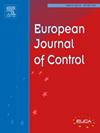一种具有稳定性和卷积输入约束保证的四轴飞行器位置跟踪的低计算饱和控制器
IF 2.6
3区 计算机科学
Q2 AUTOMATION & CONTROL SYSTEMS
引用次数: 0
摘要
在微分平面系统中,非线性动力学可以通过坐标变化和输入映射转换成等价的线性表示。尽管这种有益的线性化,但一个重要的障碍是系统约束在新空间(平坦输出空间)中具有卷积形式,这在文献中通常被忽略或通过可行域的保守近似绕过。本文基于预稳定设计和一种新颖的输入饱和分量,针对平面输出空间中四轴飞行器的位置跟踪问题,研究了非线性输入约束问题。虽然系统的稳定性被李亚普诺夫论证所证明,但该方法的实际可行性在纳米无人机平台上的模拟和实验中都得到了验证。此外,随着所提出的饱和函数的显式解的引入,这种基于平面的饱和控制器不仅保证了稳定性和约束的满足,而且需要较少的计算量,允许可能的嵌入式实现。本文章由计算机程序翻译,如有差异,请以英文原文为准。
A low computation saturated controller for a quadcopter position tracking with stability and convoluted input constraints guarantees
In the class of differentially flat systems, nonlinear dynamics can be transformed into an equivalent linear representation via a coordinate change and an input mapping. Despite this beneficial linearization, one significant hindrance is that the system constraints have a convoluted form in the new space (the flat output space), which is usually disregarded in the literature or bypassed via conservative approximation of the feasible domain. In this paper, based on a pre-stabilization design and a novel input saturation component, the nonlinear input constraints are particularly handled for the position tracking problem of quadcopters in the flat output space. While the system’s stability is shown to hold by Lyapunov arguments, the practical viability of the method is validated both in simulation and experiments over a nano-drone platform. Moreover, with the explicit solution introduced for the proposed saturation function, this flatness-based saturated controller not only ensures stability and constraints satisfaction, but also requires low computational effort, allowing possible embedded implementations.
求助全文
通过发布文献求助,成功后即可免费获取论文全文。
去求助
来源期刊

European Journal of Control
工程技术-自动化与控制系统
CiteScore
5.80
自引率
5.90%
发文量
131
审稿时长
1 months
期刊介绍:
The European Control Association (EUCA) has among its objectives to promote the development of the discipline. Apart from the European Control Conferences, the European Journal of Control is the Association''s main channel for the dissemination of important contributions in the field.
The aim of the Journal is to publish high quality papers on the theory and practice of control and systems engineering.
The scope of the Journal will be wide and cover all aspects of the discipline including methodologies, techniques and applications.
Research in control and systems engineering is necessary to develop new concepts and tools which enhance our understanding and improve our ability to design and implement high performance control systems. Submitted papers should stress the practical motivations and relevance of their results.
The design and implementation of a successful control system requires the use of a range of techniques:
Modelling
Robustness Analysis
Identification
Optimization
Control Law Design
Numerical analysis
Fault Detection, and so on.
 求助内容:
求助内容: 应助结果提醒方式:
应助结果提醒方式:


